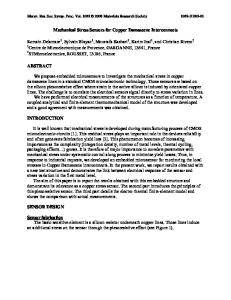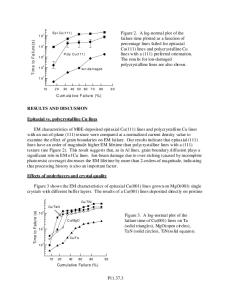Electromigration Characterization Versus Texture Analysis in Damascene Copper Interconnects
- PDF / 1,978,505 Bytes
- 6 Pages / 612 x 792 pts (letter) Page_size
- 70 Downloads / 341 Views
ELECTROMIGRATION CHARACTERIZATION VERSUS TEXTURE ANALYSIS IN DAMASCENE COPPER INTERCONNECTS. Authors : T.BERGER*, L.ARNAUD, R.GONELLA*, I.TOUET, G.LORMAND**. CEA, Direction des Technologies Avancées, 38054 Grenoble CEDEX, FRANCE. *ST MICROELECTRONICS, 38926 Crolles CEDEX, FRANCE. **GEMPPM UMR CNRS 5510, INSA, 69621 Villeurbanne CEDEX, FRANCE. ABSTRACT We have studied the effect of texture (X-ray diffraction pole figures) and grain morphology (Focus Ion Beam cross-sections) on the electromigration performances of copper damascene interconnects. Three different metallizations have been characterized : Chemical Vapor Deposition copper deposited on TiN (process A) and electroplated copper deposited either on Ta (process B) or TaN (process C). The reliability performance of these interconnects has been evaluated using both Wafer Level Reliability (WLR) and Package Level Reliability (PLR) tests on 4 and 0.6 µm wide lines using single metal level test structures. On the basis of the activation energy values and failure analysis observations, we concluded that interfacial diffusion plays a key role in the electromigration phenomenon for processes B and C whereas grain boundaries seem to be the active diffusion path for process A. The existence of several failure mechanisms during electromigration tests (interfacial or grain boundary diffusions), the impact of the damascene architecture on microstructure (sidewall textures and non columnar grain shapes) and the copper propensity for twinning seem to mask the impact of texture on the electromigration reliability of copper damascene interconnects. INTRODUCTION As a leading candidate for future interconnect material [1], Cu has been intensively studied during the last few years. The damascene process is nowadays the preferred process for Cu interconnects integration. Unlike the conventional substractive Reactive Ion Etching process (RIE), the damascene process begins with dielectric deposition. Photolithographic patterning and RIE are then used to define trenches in the dielectric. Diffusion barrier deposition and copper deposition follow the dielectric etching. The excess metal is finally removed through Chemical and Mechanical Polishing (CMP). Texture and grain size distributions where found to be key factors controlling the electromigration behavior of Al-based interconnects. A controlled texture and a large grain size provided longer electromigration (EMG) lifetimes and better electromigration performances [2,3]. In this study, we present a texture analysis (X-ray diffraction pole figures) of damascene Cu interconnects fabricated with three different processes. Several line widths ranging from 0.3µm to 3µm have been investigated for texture characterization. A qualitative grain morphology characterization has been carried out using Focus Ion Beam (FIB) cross-section imaging of the lines with a Scanning Electron Microscope (SEM). The electromigration reliability of these interconnects has been extensively studied for two line widths (w=4 and 0.6µm) using both highly and moder
Data Loading...











